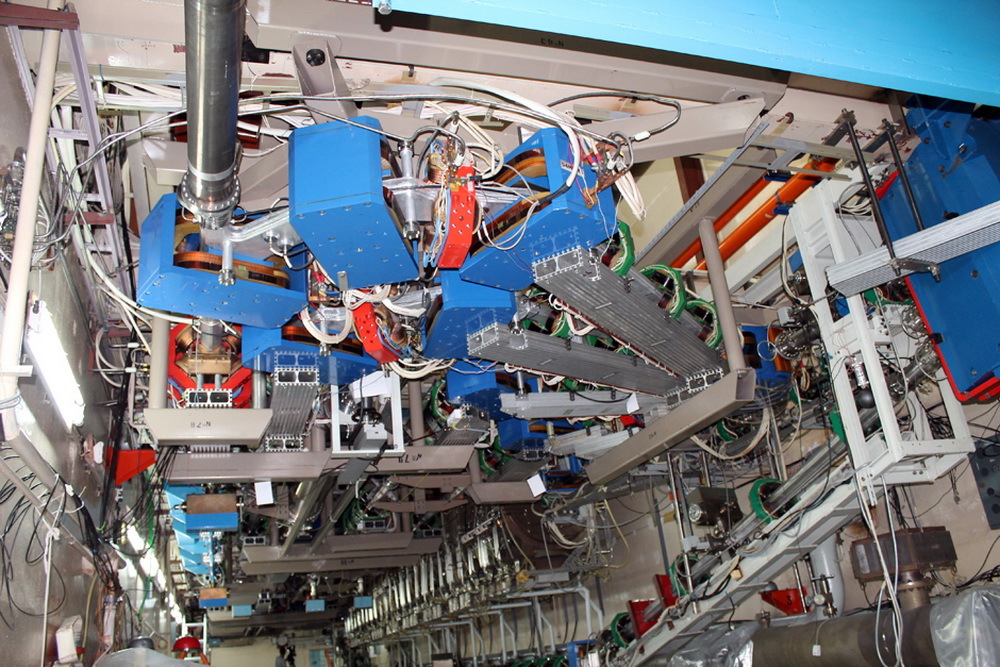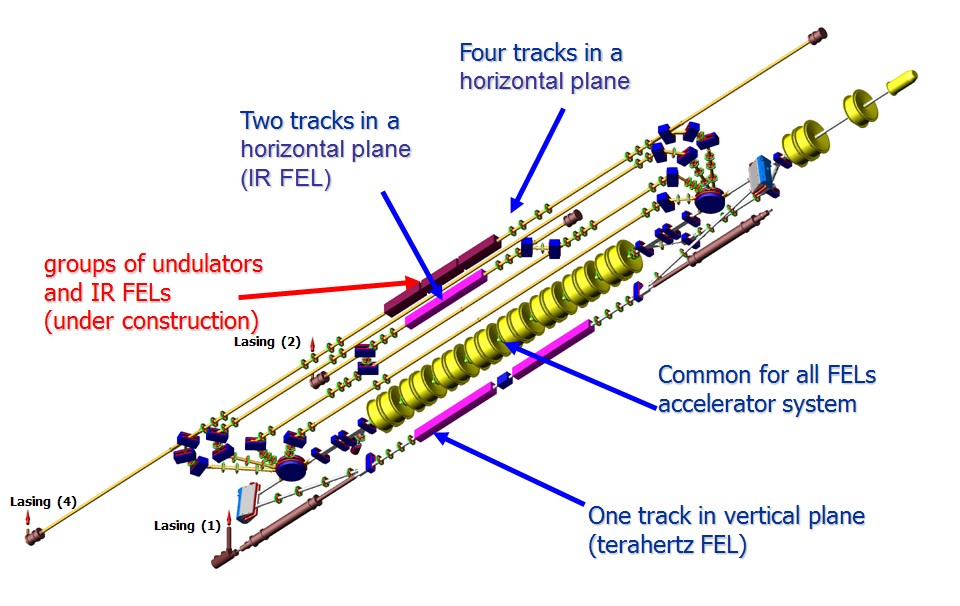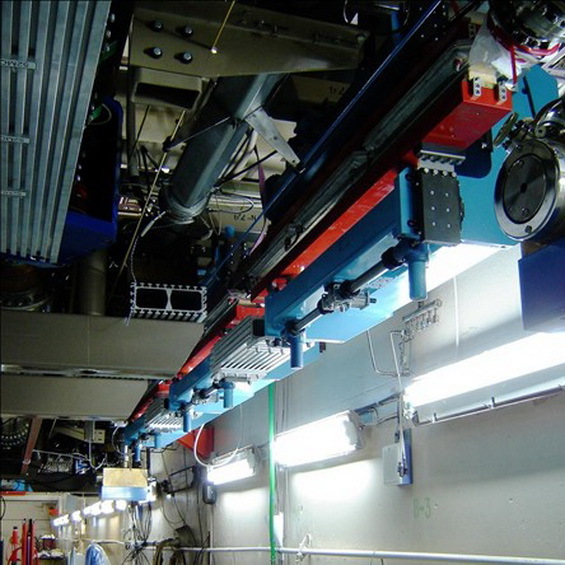Russian scientists have proposed to recharge orbital communication satellites using a free-electron laser
Russian scientists from the Institute of Nuclear Physics (BINP SB RAS) proposed a fundamentally new method of recharging orbital communication satellites. In accordance with the task, the energy for feeding the satellites will be delivered from the Earth's surface through powerful free electron lasers, Nikolai Vinokurov, head of the INP laboratory of the SB RAS, told reporters.

On July 4, a scientific conference on the synchrotron radiation of free electron lasers began its work on the basis of the Institute of Nuclear Physics in Novosibirsk. Scientists told reporters why such lasers are needed and how, thanks to them, space satellites will be able to work in the future.
“We are conducting research on synchrotron radiation and on a free electron laser,” said Nikolai Vinokurov, doctor of physical and mathematical sciences, corresponding member of the Russian Academy of Sciences, head of the research laboratory of the INP SB RAS. “A free electron laser is functioning at the Institute of Nuclear Physics. There are actually three, and they are all special. Lasers produce infrared radiation in different wavelength ranges. And we have been working with this radiation for several years with scientific users from Academgorodok institutes and other places in Russia. This is called the Community Center. This year we conducted experiments, more or less successful, on our new free electron laser, the last of three. This is a unique source of radiation that we created ourselves. This is nowhere else. We plan to improve the parameters, although they are already a record compared to world achievements. Therefore, our users have an exclusive opportunity to conduct experiments. ”
')
The Novosibirsk Free Electron Laser (FEL) consists of three accelerators, called bursts :

The first stage is a single-turn accelerator-recuperator with an electron energy of 12 MeV
The first phase of the Novosibirsk FEL was launched in 2002. At the moment, it is the world's most powerful source of terahertz radiation and an accelerator-recuperator with the highest average current.

Electrons from an electron gun pass through a “grouper” (grouping an RF resonator), an empty gap, two resonators, gaining energy of 2 MeV, the main accelerating structure, gaining another 10 MeV, and an undulator in which part of the electron energy is converted into radiation. After that, the beam returns to the main accelerating structure in the slowed down phase of the RF resonators, loses energy to the initial value (about 2 MeV) and is absorbed in the beam absorber.

The second stage - a two-turn accelerator-recuperator with an electron energy of 22 MeV

FEL of the second stage was launched in 2009. Coherent radiation was obtained in the 40–80 micron wavelength range with an average power of about 0.5 kW, which is a world record in this range. In 2010, the emission of the second FEL was transferred to the existing user stations. For the near future, it is planned to increase the radiation power and optimize the magnetic structure in order to reduce the beam loss due to the energy spread, which appears as a result of interaction with FEL radiation.
The second stage accelerator is the world's first two-turn charged particle recuperator. The installation uses the same acceleration system as the first stage. The choice of operating mode is carried out by turning on / off the turning magnets.
The third stage - a four-speed accelerator-recuperator with an electron energy of 42 MeV

May 22, 2012 received the first electron beam recovery on the third stage - the world's first four revolving accelerator-heat exchanger.
In 2013, 95% recovery and an average current of 3.2 mA were obtained at a repetition frequency of 3.75 MHz.
At present, the installation continues to install an optical resonator for generating radiation and adjusting the modes of the electron-optical structure.


Ondulators of the third stage
The first stage is located in the vertical plane, and the second and third - in the horizontal. They use the same accelerating structure, consisting of normal-conducting resonators. The choice of operating mode is carried out by turning on or off the rotating magnets.
To date, the FEL of the first and second stages have been launched. FEL of the third stage is in the process of assembly.

General view of the installation
The principle of operation of a free electron laser
The principle of operation of a free electron laser is based on the generation of relativistic radiation in a special device — an ondulator consisting of successively installed alternating magnets.

Accelerator parameters
The maximum average current obtained at the accelerator-heat exchanger of the first stage of the Novosibirsk FEL is still a record in this class of machines. The second and third stages are the world's first multi-speed recuperator boosters. Installation parameters are presented in the table.

Radiation parameters
The average power of terahertz radiation received at Novosibirsk FEL is a record in this wavelength range. In the Siberian center of synchrotron and terahertz radiation, terahertz radiation is performed by 20 groups of 12 scientific organizations in Novosibirsk, Moscow, and South Korea. The radiation parameters are presented in the table.

“For us, the creation of high-power free-electron lasers has one more important direction. The point is this: the number of communications satellites is constantly growing. In this case, the satellites have a certain limitation on the power supply. So, solar panels give about 10 kilowatts. If the satellites are powered from the Earth by radiation, for example, infrared, then it can be done so that 100 kilowatts of power are available to this satellite. If we make several free electron lasers, we will be able to get a new qualitative leap in the development of space communications. High-power free electron lasers have practical value. The use of solar energy by satellites can be compared to sailing energy. Whatever good sailers were, no matter how fast they went, the steamers won anyway. Why? Because the active engine. If we can provide satellites with energy from the Earth using free-electron lasers, we have completely new opportunities, like when steamboats appeared at the time of sailboats, ”explained the doctor of physical and mathematical sciences, corresponding member of the Russian Academy of Sciences, head of the research laboratory INP SB RAS Nikolai Vinokurov.
The full cycle of introducing the technology of satellite power to lasers will cost approximately 1 billion rubles. Whether there are investors willing to invest such an amount in a promising project, time will tell.
The site of the INP SB RAS
academ.info
Tass
That's all with you was Dronk.Ru. Do not forget to return money for purchases in China and subscribe to our blog , there will be many more interesting things.

We recommend:
- Save up to 8% on every purchase on AliExpress and other online stores in China
- Why do online stores give money for purchases?
- Return your money - Choose a cashback service for Aliexpress
- The history of the development of Dronk.ru - from choosing quadcopters to returning money for purchases on AliExpress and not only
- The best cashback service or 5 main criteria for evaluating cashback service

On July 4, a scientific conference on the synchrotron radiation of free electron lasers began its work on the basis of the Institute of Nuclear Physics in Novosibirsk. Scientists told reporters why such lasers are needed and how, thanks to them, space satellites will be able to work in the future.
“We are conducting research on synchrotron radiation and on a free electron laser,” said Nikolai Vinokurov, doctor of physical and mathematical sciences, corresponding member of the Russian Academy of Sciences, head of the research laboratory of the INP SB RAS. “A free electron laser is functioning at the Institute of Nuclear Physics. There are actually three, and they are all special. Lasers produce infrared radiation in different wavelength ranges. And we have been working with this radiation for several years with scientific users from Academgorodok institutes and other places in Russia. This is called the Community Center. This year we conducted experiments, more or less successful, on our new free electron laser, the last of three. This is a unique source of radiation that we created ourselves. This is nowhere else. We plan to improve the parameters, although they are already a record compared to world achievements. Therefore, our users have an exclusive opportunity to conduct experiments. ”
')
The Novosibirsk Free Electron Laser (FEL) consists of three accelerators, called bursts :

The first stage is a single-turn accelerator-recuperator with an electron energy of 12 MeV
The first phase of the Novosibirsk FEL was launched in 2002. At the moment, it is the world's most powerful source of terahertz radiation and an accelerator-recuperator with the highest average current.

Electrons from an electron gun pass through a “grouper” (grouping an RF resonator), an empty gap, two resonators, gaining energy of 2 MeV, the main accelerating structure, gaining another 10 MeV, and an undulator in which part of the electron energy is converted into radiation. After that, the beam returns to the main accelerating structure in the slowed down phase of the RF resonators, loses energy to the initial value (about 2 MeV) and is absorbed in the beam absorber.

The second stage - a two-turn accelerator-recuperator with an electron energy of 22 MeV

FEL of the second stage was launched in 2009. Coherent radiation was obtained in the 40–80 micron wavelength range with an average power of about 0.5 kW, which is a world record in this range. In 2010, the emission of the second FEL was transferred to the existing user stations. For the near future, it is planned to increase the radiation power and optimize the magnetic structure in order to reduce the beam loss due to the energy spread, which appears as a result of interaction with FEL radiation.
The second stage accelerator is the world's first two-turn charged particle recuperator. The installation uses the same acceleration system as the first stage. The choice of operating mode is carried out by turning on / off the turning magnets.
The third stage - a four-speed accelerator-recuperator with an electron energy of 42 MeV

May 22, 2012 received the first electron beam recovery on the third stage - the world's first four revolving accelerator-heat exchanger.
In 2013, 95% recovery and an average current of 3.2 mA were obtained at a repetition frequency of 3.75 MHz.
At present, the installation continues to install an optical resonator for generating radiation and adjusting the modes of the electron-optical structure.


Ondulators of the third stage
The first stage is located in the vertical plane, and the second and third - in the horizontal. They use the same accelerating structure, consisting of normal-conducting resonators. The choice of operating mode is carried out by turning on or off the rotating magnets.
To date, the FEL of the first and second stages have been launched. FEL of the third stage is in the process of assembly.

General view of the installation
The principle of operation of a free electron laser
The principle of operation of a free electron laser is based on the generation of relativistic radiation in a special device — an ondulator consisting of successively installed alternating magnets.

Accelerator parameters
The maximum average current obtained at the accelerator-heat exchanger of the first stage of the Novosibirsk FEL is still a record in this class of machines. The second and third stages are the world's first multi-speed recuperator boosters. Installation parameters are presented in the table.

Radiation parameters
The average power of terahertz radiation received at Novosibirsk FEL is a record in this wavelength range. In the Siberian center of synchrotron and terahertz radiation, terahertz radiation is performed by 20 groups of 12 scientific organizations in Novosibirsk, Moscow, and South Korea. The radiation parameters are presented in the table.

“For us, the creation of high-power free-electron lasers has one more important direction. The point is this: the number of communications satellites is constantly growing. In this case, the satellites have a certain limitation on the power supply. So, solar panels give about 10 kilowatts. If the satellites are powered from the Earth by radiation, for example, infrared, then it can be done so that 100 kilowatts of power are available to this satellite. If we make several free electron lasers, we will be able to get a new qualitative leap in the development of space communications. High-power free electron lasers have practical value. The use of solar energy by satellites can be compared to sailing energy. Whatever good sailers were, no matter how fast they went, the steamers won anyway. Why? Because the active engine. If we can provide satellites with energy from the Earth using free-electron lasers, we have completely new opportunities, like when steamboats appeared at the time of sailboats, ”explained the doctor of physical and mathematical sciences, corresponding member of the Russian Academy of Sciences, head of the research laboratory INP SB RAS Nikolai Vinokurov.
The full cycle of introducing the technology of satellite power to lasers will cost approximately 1 billion rubles. Whether there are investors willing to invest such an amount in a promising project, time will tell.
The site of the INP SB RAS
academ.info
Tass
That's all with you was Dronk.Ru. Do not forget to return money for purchases in China and subscribe to our blog , there will be many more interesting things.

We recommend:
- Save up to 8% on every purchase on AliExpress and other online stores in China
- Why do online stores give money for purchases?
- Return your money - Choose a cashback service for Aliexpress
- The history of the development of Dronk.ru - from choosing quadcopters to returning money for purchases on AliExpress and not only
- The best cashback service or 5 main criteria for evaluating cashback service
Source: https://habr.com/ru/post/395749/
All Articles